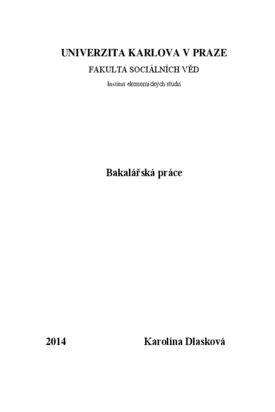Analýza poptávky po mase v České republice
Analysis of meat demand in the Czech Republic
bakalářská práce (OBHÁJENO)

Zobrazit/
Trvalý odkaz
http://hdl.handle.net/20.500.11956/72460Identifikátory
SIS: 125095
Kolekce
- Kvalifikační práce [17123]
Autor
Vedoucí práce
Oponent práce
Polák, Petr
Fakulta / součást
Fakulta sociálních věd
Obor
Ekonomie
Katedra / ústav / klinika
Institut ekonomických studií
Datum obhajoby
16. 6. 2014
Nakladatel
Univerzita Karlova, Fakulta sociálních vědJazyk
Čeština
Známka
Výborně
Klíčová slova (česky)
maso, hovězí, drůbeží, vepřové, ryby, poptávka, elasticita, determinanty spotřebyKlíčová slova (anglicky)
meat, beef, poultry, pork, fish, demand, elasticity, determinants of consumptionMaso a masné výrobky tvoří největší podíl na výdajích českých domácností za potraviny. Tato práce nabízí komplexní pohled na trh s masem v České republice a detailně mapuje determinanty poptávky po něm. Přináší přehled nejpoužívanějších poptávkových modelů, z nichž pro empirickou analýzu volí log-log model odhadovaný metodou nejmenších čtverců. Jádrem práce je odhad vlastních cenových a důchodových elasticit poptávky po mase a jeho jednotlivých druzích ze statistik rodinných účtů za roky 2000 až 2012. Odhady jsou až na cenovou elasticitu poptávky po hovězím mase, která je rovna 0,13, konzistentní s předchozími studiemi na toto téma. Domácnosti za sledované období vykazují jednotkovou důchodovou elasticitu poptávky po mase a cenovou elasticitu rovnu -1,2. Vývoj elasticit se pro jednotlivé druhy masa různí. Analyzovány jsou i významné sociodemografické vlivy na množství poptávaného masa, jako je přítomnost ženy v čele domácnosti, výše dosaženého vzdělání, věk a další.
Meat and meat products form the highest share of Czech household expenditures for food. This thesis offers a complex view on the Czech meat market and studies in detail the determinants of meat demand. A review of the most frequently used demand models is included, from which the least squares log-log model is used for empirical analysis. The core of this thesis is the estimation of price and income elasticities of demand for various types of meat based on statistical data of household accounts from the years 2000 - 2012. The estimates are, with the exception of the price elasticity for beef, which equals 0.13, consistent with previous studies. Within the examined period, households manifest unitary income elasticity and own price elasticity of demand for meat equal to -1.2. The temporal evolution of elasticities varies for different types of meat. Important socio-demographical aspects influencing the demand for meat, such as age, education, whether the household is led by a female, and others, are also analysed.
